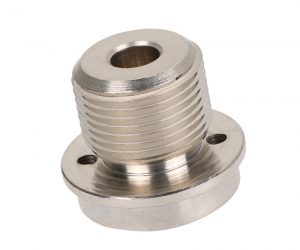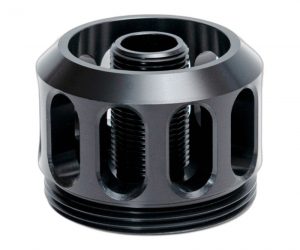The Unseen Architects of Flight: A Deep Dive into Precision Aerospace CNC Machining. The future trajectory of aerospace CNC machining is not simply an evolution, but a paradigm shift. Providers are not merely adapting; they are proactively shaping the future through a synergistic convergence of cutting-edge technologies. The integration of AI-driven predictive maintenance, advanced additive manufacturing processes, and the exploration of novel, high-performance materials promises to redefine the very limits of what is achievable in aerospace component fabrication. This is not merely progress; it is a relentless pursuit of perfection, a testament to human ingenuity's unwavering ambition to conquer the skies.
I. Beyond Precision: The Existential Imperative of Aerospace Machining
A. The Criticality of Micron-Level Perfection: Modern aviation's breathtaking feats – from supersonic sprints to orbital maneuvers – are fundamentally predicated on the invisible architecture of meticulously crafted components. These parts, born from the crucible of Computer Numerical Control (CNC) machining, represent not merely engineering prowess, but a commitment to absolute, often existential, precision. Failure is not an option; the consequences are too dire to contemplate.
B. A Genealogy of Innovation, Forged in the Fires of Necessity: Aerospace machining's evolution is a relentless pursuit of the unattainable. From the rudimentary lathes of aviation's nascent years to the hyper-sophisticated, multi-axis behemoths of today, each incremental advance has been driven by the insatiable demand for increased performance, reduced weight, and unwavering reliability in increasingly hostile operational environments. This relentless push has blurred the lines between manufacturing and scientific exploration.
II. Where the Theoretical Meets the Tangible: The Extreme Demands of Aerospace Machining
A. Tolerances as a Measure of Existential Risk: The tolerances demanded in aerospace CNC machining transcend mere engineering specifications; they define the very boundaries of acceptable risk. Micron-level deviations, imperceptible to the naked eye, can cascade into catastrophic failures. The relentless pursuit of zero-defect manufacturing is not a marketing slogan; it's a matter of life and death.
B. Materials Science at the Edge of Possibility: The materials employed – exotic alloys of titanium, nickel, and aluminum, often reinforced with carbon fiber or ceramic matrix composites – represent the pinnacle of materials science. Their machining presents a formidable challenge, requiring specialized tooling, advanced cutting strategies, and a deep understanding of material behavior under extreme stress, temperature, and pressure. The slightest miscalculation can render a component unusable, jeopardizing the entire project.
III. The Technological Singularity of Aerospace CNC Machining
A. Machines as Extensions of Human Ingenuity (and its Limitations): The CNC machines themselves are marvels of engineering, capable of executing complex multi-axis movements with sub-micron accuracy. These are not merely machines; they are sophisticated, highly automated systems integrating advanced sensors, feedback loops, and predictive algorithms to compensate for variations in material properties, tooling wear, and environmental factors. They are, in essence, self-correcting systems operating at the edge of physical possibility.
B. The Algorithmic Heart of Aerospace Manufacturing: The software driving these machines is equally sophisticated, employing advanced CAD/CAM systems capable of generating incredibly complex toolpaths, optimizing machining strategies, and simulating the entire manufacturing process to predict potential problems before they occur. This algorithmic precision is crucial in minimizing material waste, maximizing efficiency, and ensuring consistent quality across a potentially vast production run.
IV. Quality Assurance: A Symphony of Rigor and Innovation
A. Certification: The Unwavering Guardian of Safety: Aerospace CNC machining operates under an unforgiving regime of rigorous testing and certification. Every component undergoes a battery of tests, from non-destructive evaluations to simulated operational stresses, ensuring compliance with stringent industry standards and regulatory requirements. These standards are not merely suggestions; they are legally binding mandates.
B. Proactive Quality Control: Anticipating the Unforeseen: Beyond meeting regulatory requirements, leading aerospace CNC machining facilities employ proactive quality control measures, integrating in-process monitoring, advanced metrology, and real-time data analysis to identify and correct potential defects before they become critical. This commitment to continuous improvement reflects a deep understanding that perfection, in this context, is not a destination but a continuous journey. The pursuit of flawlessness is not just a goal; it is a necessity.
V. Aerospace Application Variants: A Symphony of Precision and Power
A. Propulsion's Core: Engine Components and Thrust Generation – The aerospace sector's relentless pursuit of efficiency and performance hinges on the intricate dance of engine components. CNC machining, a virtuoso in this performance, orchestrates the creation of mission-critical elements: turbine blades sculpted with aerodynamic finesse, compressor disks engineered to withstand unimaginable stresses, nozzle assemblies meticulously crafted to channel raw power, and thrust reverser components designed for controlled deceleration. Failure is not an option; precision is paramount.
B. Airframe Architecture: Structural Integrity and Internal Refinement – Beyond the heart of propulsion, the airframe itself demands the unwavering precision of CNC machining. The structural integrity of aircraft and spacecraft rests upon meticulously machined ribs, spars, and bulkheads, each a testament to engineering prowess. Furthermore, the intricate network of fittings and fasteners, invisibly binding the airframe, represents a silent symphony of perfectly coordinated components, ensuring the structural integrity of the entire aerial platform. A single imperfection can jeopardize the entire system.
C. Propulsion and Exhaust Systems: A Controlled Explosion of Power – The creation of propulsion and exhaust systems demands a level of precision that transcends mere accuracy. From the complex geometries of rocket nozzles, capable of withstanding extreme temperatures and pressures, to the meticulously engineered components of turboprop and turboshaft engines, and the advanced jet propulsion systems that define modern flight, CNC machining serves as the indispensable architect of controlled power. The slightest deviation can lead to catastrophic consequences.
VI. The Logistical Labyrinth: Navigating the Complexities of Aerospace Component Delivery
A. From Cradle to Flight: Orchestrating the Supply Chain – The journey of an aerospace CNC machined component is far from straightforward. It's a meticulously choreographed ballet of logistics, a complex interplay of timing, precision, and unwavering adherence to stringent quality control and transportation protocols. Each step, from the manufacturing floor to the final installation, demands flawless execution; any disruption risks jeopardizing the entire operation.
B. Global Collaboration: A Network of Expertise and Resources – The aerospace industry's insatiable demand for advanced components necessitates a global network of collaboration. CNC machining providers must forge strategic partnerships with material suppliers, engineering teams, and Original Equipment Manufacturers (OEMs), leveraging a diverse pool of expertise and resources. This intricate web of interconnectedness is crucial for delivering components that meet the industry's exacting standards.
VII. The Future of Aerospace CNC Machining: A Vision of Enhanced Precision and Innovation
A. Technological Convergence: Additive Manufacturing and Artificial Intelligence – The future of aerospace CNC machining is inextricably linked to technological advancements. The integration of additive manufacturing techniques promises to revolutionize component design, while the incorporation of artificial intelligence and machine learning algorithms offers the potential for unprecedented process optimization, pushing the boundaries of precision and efficiency. The convergence of these technologies promises a paradigm shift.
B. Material Science and Design Evolution: Pushing the Limits of Performance – The demand for lighter, stronger, and more performance-oriented aerospace components will drive innovation in material science and design. CNC machining providers will be at the forefront of developing advanced alloys, composites, and geometries, constantly pushing the limits of what's achievable in the unforgiving environment of flight. The sky is no longer the limit; it's the starting point.
VIII. Conclusion: A Confluence of Precision and Innovation in Aerospace CNC Machining
The aerospace industry's relentless pursuit of operational excellence finds its apotheosis in the realm of CNC machined parts. These components, far from being mere functional elements, represent a sophisticated synthesis of engineering artistry and technological prowess. From the minuscule intricacies of turbine blades to the robust architecture of spacecraft structural assemblies, these parts are the silent protagonists in the ongoing narrative of human flight, pushing the boundaries of performance and safety to unprecedented levels. Their creation is not merely manufacturing; it is a precision-driven choreography, a delicate dance between material science, advanced machining techniques, and unwavering quality control.
FAQs:
Q: Deconstructing Precision: Specifications, Tolerances, and Quality Assurance in Aerospace CNC Machining.
A: Aerospace CNC machining operates within a hyper-precise ecosystem, where tolerances are measured not in millimeters, but in microns, demanding an unwavering commitment to quality. This necessitates the deployment of advanced CNC machine tools possessing sub-micron accuracy, specialized tooling capable of handling exotic materials, and sophisticated quality control systems incorporating real-time process monitoring and statistical process control (SPC) methodologies. Rigorous testing, often exceeding industry standards, ensures unwavering compliance with stringent certification requirements, guaranteeing both performance and safety.
Q: The Material Matrix: Navigating the Challenges of Advanced Aerospace Alloys.
A: The selection and machining of aerospace alloys—lightweight aluminum alloys, high-strength titanium, nickel-based superalloys—represent a significant engineering challenge. The inherent properties of these materials, their varying machinability characteristics, and the need for precise control over surface finish and dimensional accuracy demand a deep understanding of materials science, coupled with specialized machining expertise. This includes optimized cutting strategies, advanced tool path generation, and the implementation of specialized cooling and lubrication techniques to mitigate thermal stresses and tool wear.
Q: Application Versatility: The Ubiquitous Role of CNC Machined Parts in Aerospace Systems.
A: The applications of aerospace CNC machined parts are as diverse as the aerospace industry itself. From the heart of propulsion systems—turbine blades, combustor components, and intricate nozzle assemblies—to the structural integrity of airframes, landing gear, and satellite components, these parts are fundamental to the functionality and reliability of flight systems. Their role extends to critical control systems, avionics housings, and even life support equipment, underscoring their pervasive importance across the entire aerospace ecosystem.
Q: Supply Chain Symphony: Orchestrating the Complex Logistics of Aerospace Component Delivery.
A: The supply chain for aerospace CNC machined parts is a complex, highly regulated ecosystem demanding meticulous coordination and collaboration. Providers must navigate stringent quality assurance protocols, adhere to demanding traceability requirements, and manage complex logistics across global networks. This necessitates robust partnerships with material suppliers, engineering firms, and Original Equipment Manufacturers (OEMs), ensuring seamless integration and timely delivery of components, while maintaining the highest standards of quality and operational efficiency.
Q: Technological Horizons: The Future of Precision Aerospace Manufacturing.
A: The future of aerospace CNC machining is characterized by a convergence of disruptive technologies. The integration of AI-driven process optimization, advanced sensor technologies for real-time process monitoring, and the adoption of hybrid manufacturing techniques—combining subtractive and additive processes—promises to revolutionize the industry. Furthermore, the development of novel materials with enhanced performance characteristics will further challenge and refine the capabilities of CNC machining, driving the industry towards new frontiers of precision and efficiency.

